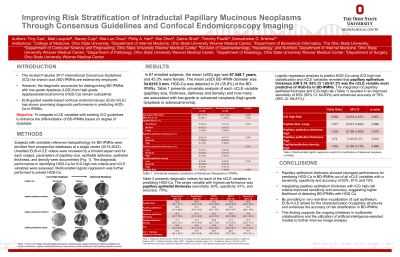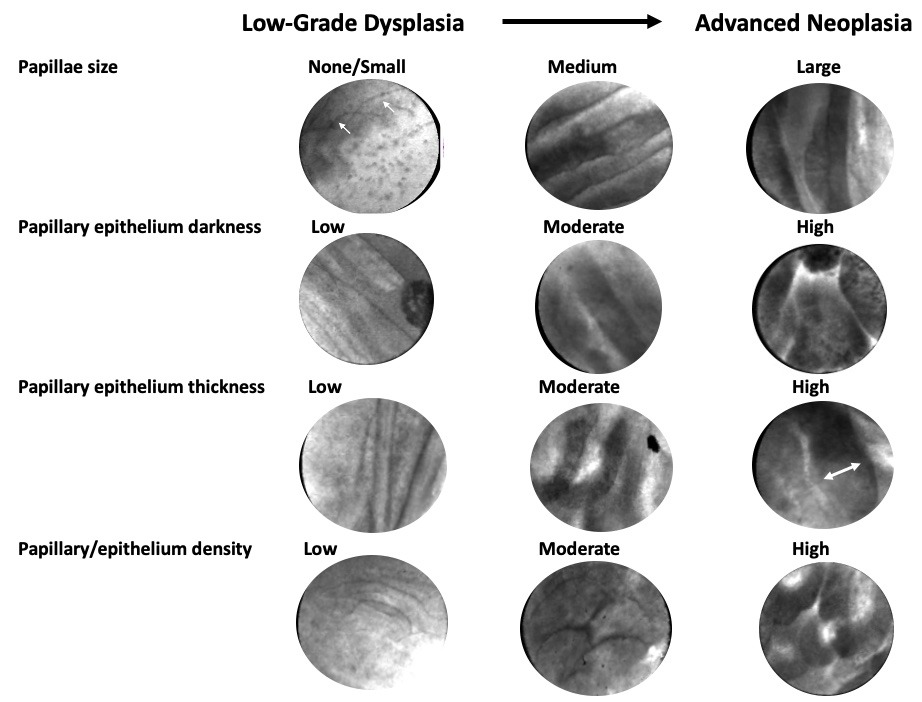Monday Poster Session
Category: Biliary/Pancreas
P1423 - Improving Risk Stratification of Intraductal Papillary Mucinous Neoplasms Through Consensus Guidelines and Confocal Endomicroscopy Imaging
Monday, October 23, 2023
10:30 AM - 4:15 PM PT
Location: Exhibit Hall

Has Audio

Troy Cao, BS
Ohio State University Wexner Medical Center
Columbus, OH
Presenting Author(s)
Troy Cao, BS1, Matt Leupold, MD2, Stacey Culp, PhD3, Wei-Lun Chao, PhD4, Phil Hart, MD3, Wei Chen, MD, PhD1, Zarine Shah, MD1, Timothy Pawlik, MD, PhD, MPH, MBA1, Somashekar Krishna, MD5
1Ohio State University Wexner Medical Center, Columbus, OH; 2The Ohio State University Wexner Medical Center, Columbus, OH; 3The Ohio State University, Columbus, OH; 4Ohio State University, Columbus, OH; 5The Ohio State Wexner Medical Center, Columbus, OH
Introduction: The revised Fukuoka 2017 International Consensus Guidelines (ICG) for branch duct (BD)-IPMNs are extensively employed; however, the diagnostic accuracies for distinguishing BD-IPMNs with low-grade dysplasia (LGD) from high-grade dysplasia/adenocarcinoma (HGD-Ca) remain suboptimal. EUS-guided needle-based confocal endomicroscopy (EUS-nCLE) has shown promising diagnostic performance in predicting HGD-Ca in IPMNs. The objective of this study is to integrate nCLE variables with existing ICG guidelines to enhance the differentiation of BD-IPMNs.
Methods: Subjects with available reference histopathology for BD-IPMNs were enrolled from prospective databases at a single center (2015-2023). Unedited EUS-nCLE videos were reviewed by a blinded expert and for each subject, parameters of papillary size, epithelial darkness, epithelial thickness, and density were documented (Fig. 1). The diagnostic performance in identifying HGD-Ca for ICG high-risk criteria and nCLE variables were assessed. Multivariable logistic regression was further performed to predict HGD-Ca.
Results: In 67 enrolled subjects, the mean (±SD) age was 67.5±9.7 years, and 43.3% were female. The mean (±SD) BD-IPMN diameter was 34.6±10.3 mm. HGD-Ca was detected in 24 (35.8%) of the BD-IPMNs. The sensitivity, specificity, and accuracy for detecting HGD-Ca using the 2017 ICG high-risk criteria were 46% (95% CI: 28-65%), 93% (95% CI: 81-98%), and 76% (95% CI: 65-85%), respectively. Table 1 presents diagnostic indices for each of the nCLE variables in predicting HGD-Ca. The variable with highest performance was papillary epithelial thickness (sensitivity: 63%, specificity: 81%, and accuracy: 75%). Logistic regression analysis to predict HGD-Ca using ICG high-risk classification and nCLE variables revealed that papillary epithelium thickness (OR 9.74, 95% CI 1.65-57.37) was the nCLE variable most predictive of HGD-Ca in BD-IPMNs. The integration of papillary epithelial thickness and ICG-high risk (Table 1) resulted in an improved sensitivity of 83% (95% CI: 64-93%) and enhanced accuracy of 79% (95% CI: 68-87%).
Discussion: By providing in vivo real-time visualization of cyst epithelium, EUS-nCLE allows for the characterization of papillary structures and enhances the accuracy of risk stratification in BD-IPMNs. This finding supports the ongoing initiatives in multicenter collaborations and the utilization of artificial intelligence-assisted models to further improve image analysis.

Disclosures:
Troy Cao, BS1, Matt Leupold, MD2, Stacey Culp, PhD3, Wei-Lun Chao, PhD4, Phil Hart, MD3, Wei Chen, MD, PhD1, Zarine Shah, MD1, Timothy Pawlik, MD, PhD, MPH, MBA1, Somashekar Krishna, MD5. P1423 - Improving Risk Stratification of Intraductal Papillary Mucinous Neoplasms Through Consensus Guidelines and Confocal Endomicroscopy Imaging, ACG 2023 Annual Scientific Meeting Abstracts. Vancouver, BC, Canada: American College of Gastroenterology.
1Ohio State University Wexner Medical Center, Columbus, OH; 2The Ohio State University Wexner Medical Center, Columbus, OH; 3The Ohio State University, Columbus, OH; 4Ohio State University, Columbus, OH; 5The Ohio State Wexner Medical Center, Columbus, OH
Introduction: The revised Fukuoka 2017 International Consensus Guidelines (ICG) for branch duct (BD)-IPMNs are extensively employed; however, the diagnostic accuracies for distinguishing BD-IPMNs with low-grade dysplasia (LGD) from high-grade dysplasia/adenocarcinoma (HGD-Ca) remain suboptimal. EUS-guided needle-based confocal endomicroscopy (EUS-nCLE) has shown promising diagnostic performance in predicting HGD-Ca in IPMNs. The objective of this study is to integrate nCLE variables with existing ICG guidelines to enhance the differentiation of BD-IPMNs.
Methods: Subjects with available reference histopathology for BD-IPMNs were enrolled from prospective databases at a single center (2015-2023). Unedited EUS-nCLE videos were reviewed by a blinded expert and for each subject, parameters of papillary size, epithelial darkness, epithelial thickness, and density were documented (Fig. 1). The diagnostic performance in identifying HGD-Ca for ICG high-risk criteria and nCLE variables were assessed. Multivariable logistic regression was further performed to predict HGD-Ca.
Results: In 67 enrolled subjects, the mean (±SD) age was 67.5±9.7 years, and 43.3% were female. The mean (±SD) BD-IPMN diameter was 34.6±10.3 mm. HGD-Ca was detected in 24 (35.8%) of the BD-IPMNs. The sensitivity, specificity, and accuracy for detecting HGD-Ca using the 2017 ICG high-risk criteria were 46% (95% CI: 28-65%), 93% (95% CI: 81-98%), and 76% (95% CI: 65-85%), respectively. Table 1 presents diagnostic indices for each of the nCLE variables in predicting HGD-Ca. The variable with highest performance was papillary epithelial thickness (sensitivity: 63%, specificity: 81%, and accuracy: 75%). Logistic regression analysis to predict HGD-Ca using ICG high-risk classification and nCLE variables revealed that papillary epithelium thickness (OR 9.74, 95% CI 1.65-57.37) was the nCLE variable most predictive of HGD-Ca in BD-IPMNs. The integration of papillary epithelial thickness and ICG-high risk (Table 1) resulted in an improved sensitivity of 83% (95% CI: 64-93%) and enhanced accuracy of 79% (95% CI: 68-87%).
Discussion: By providing in vivo real-time visualization of cyst epithelium, EUS-nCLE allows for the characterization of papillary structures and enhances the accuracy of risk stratification in BD-IPMNs. This finding supports the ongoing initiatives in multicenter collaborations and the utilization of artificial intelligence-assisted models to further improve image analysis.

Figure: EUS-nCLE images illustrating different degrees of papillae size, papillary epithelium darkness (representing nuclear stratification), papillary epithelium thickness (representing cellular stratification) and papillary/epithelium density.
Disclosures:
Troy Cao indicated no relevant financial relationships.
Matt Leupold indicated no relevant financial relationships.
Stacey Culp indicated no relevant financial relationships.
Wei-Lun Chao indicated no relevant financial relationships.
Phil Hart indicated no relevant financial relationships.
Wei Chen indicated no relevant financial relationships.
Zarine Shah indicated no relevant financial relationships.
Timothy Pawlik indicated no relevant financial relationships.
Somashekar Krishna: Mauna Kea Technologies – Grant/Research Support. Taewoong Medical USA – Grant/Research Support. US Biotest – Grant/Research Support.
Troy Cao, BS1, Matt Leupold, MD2, Stacey Culp, PhD3, Wei-Lun Chao, PhD4, Phil Hart, MD3, Wei Chen, MD, PhD1, Zarine Shah, MD1, Timothy Pawlik, MD, PhD, MPH, MBA1, Somashekar Krishna, MD5. P1423 - Improving Risk Stratification of Intraductal Papillary Mucinous Neoplasms Through Consensus Guidelines and Confocal Endomicroscopy Imaging, ACG 2023 Annual Scientific Meeting Abstracts. Vancouver, BC, Canada: American College of Gastroenterology.
